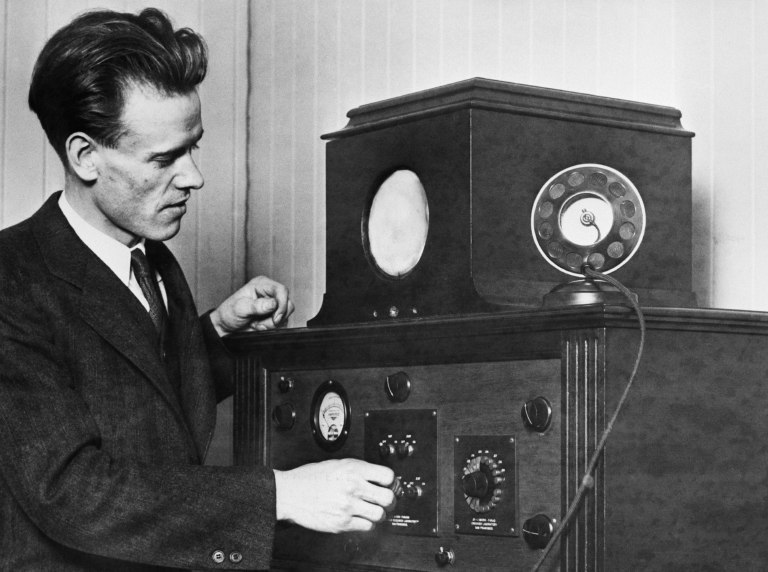Electronic Technology: Zworykin and Farnsworth
The story of television’s invention included a complex patents battle between two independent inventors: Vladimir Zworykin and Philo Farnsworth. It began in Russia in 1907, when physicist Boris Rosing improved Nipkow’s mechanical scanning device. Rosing’s lab assistant, Vladimir Zworykin, left Russia for America in 1919 and went to work for Westinghouse and then RCA. In 1923, Zworykin invented the iconoscope, the first TV camera tube to convert light rays into electrical signals, and he received a patent for it in 1928.

Around the same time, Idaho teenager Philo Farnsworth also figured out that a mechanical scanning system would not send pictures through the air over long distances. On September 7, 1927, the twenty-one-year-old Farnsworth transmitted the first electronic TV picture: He rotated a straight line scratched on a square of painted glass by 90 degrees. RCA, then the world leader in broadcasting technology, challenged Farnsworth in a major patents battle, in part over Zworykin’s innovations for Westinghouse and RCA. Farnsworth had to rely on his high-school science teacher to retrieve his original drawings from 1922. Finally, in 1930, Farnsworth received a patent for the first electronic television.
After the company’s court defeat, RCA’s president, David Sarnoff, had to negotiate to use Farnsworth’s patents. Farnsworth later licensed these patents to RCA and AT&T for use in the commercial development of television. At the end of television’s development stage, Farnsworth conducted the first public demonstration of television at the Franklin Institute in Philadelphia in 1934—five years before RCA’s famous public demonstration at the 1939 World’s Fair.
Setting Technical Standards
“There’s nothing on it worthwhile, and we’re not going to watch it in this household, and I don’t want it in your intellectual diet.”
KENT FARNSWORTH, RECALLING THE ATTITUDE OF HIS FATHER (PHILO) TOWARD TV WHEN KENT WAS GROWING UP
Figuring out how to push TV as a business and elevate it to a mass medium meant creating a coherent set of technical standards for product manufacturers. In the late 1930s, the National Television Systems Committee (NTSC), a group representing major electronics firms, began outlining industry-wide manufacturing practices and compromising on technical standards. As a result, in 1941 the Federal Communications Commission (FCC) adopted an analog standard (based on radio waves) for all U.S. TV sets. About thirty countries, including Japan, Canada, Mexico, Saudi Arabia, and most Latin American nations, also adopted this system. (Most of Europe and Asia, however, adopted a slightly superior technical system shortly thereafter.)
The United States continued to use analog signals until 2009, when they were replaced by digital signals. These translate TV images and sounds into binary codes (ones and zeros like computers use) and allow for increased channel capacity and improved image quality and sound. HDTV, or high-definition television, digital signals offer the highest resolution and sharpest image. Receiving a “hi-def” picture depends on two things: the programmer must use a high-definition signal, and consumers must have HDTV equipment to receive and view it. The switch to digital signals has also opened up new avenues for receiving and viewing television on laptops, smartphones, and tablets.
Assigning Frequencies and Freezing TV Licenses
In the early days of television, the number of TV stations a city or market could support was limited because airwave spectrum frequencies interfered with one another. So a market could have a channel 2 and a channel 4 but not a channel 3. Cable systems “fixed” this problem by sending channels through cable wires that don’t interfere with one another. Today, a frequency that once carried one analog TV signal can now carry eight or nine compressed digital channels.
In the 1940s, the FCC began assigning channels in specific geographic areas to make sure there was no interference. As a result, for years New Jersey had no TV stations because those signals would have interfered with the New York stations. But by 1948 the FCC had issued nearly one hundred TV licenses, and there was growing concern about the finite number of channels and the frequency-interference problems. The FCC declared a freeze on new licenses from 1948 to 1952.
During this time, cities such as New York, Chicago, and Los Angeles had several TV stations, while other areas—including Little Rock, Arkansas, and Portland, Oregon—had none. In non-TV cities, movie audiences increased. But cities with TV stations saw a 20 to 40 percent drop in movie attendance during this period; more than sixty movie theaters closed in the Chicago area alone. Taxi receipts and nightclub attendance also fell in TV cities, as did library book circulation. Radio listening also declined; for example, Bob Hope’s network radio show lost half its national audience between 1949 and 1951. By 1951, the sales of television sets had surpassed the sales of radio receivers.
After a second NTSC conference in 1952 sorted out the technical problems, the FCC ended the licensing freeze, and almost thirteen hundred communities received TV channel allocations. By the mid-1950s, there were more than four hundred television stations in operation—a 400 percent surge since the prefreeze era—and television became a mass medium. Today, about seventeen hundred TV stations are in operation.
The Introduction of Color Television
In 1952, the FCC tentatively approved an experimental CBS color system. However, because black-and-white TV sets could not receive its signal, the system was incompatible with the sets most Americans owned. In 1954, RCA’s color system, which sent TV images in color but allowed older sets to receive the color images as black-and-white, usurped CBS’s system to become the color standard. Although NBC began broadcasting a few shows in color in the mid-1950s, it wasn’t until 1966, when the consumer market for color sets had taken off, that the Big Three networks (CBS, NBC, and ABC) broadcast their entire evening lineups in color.